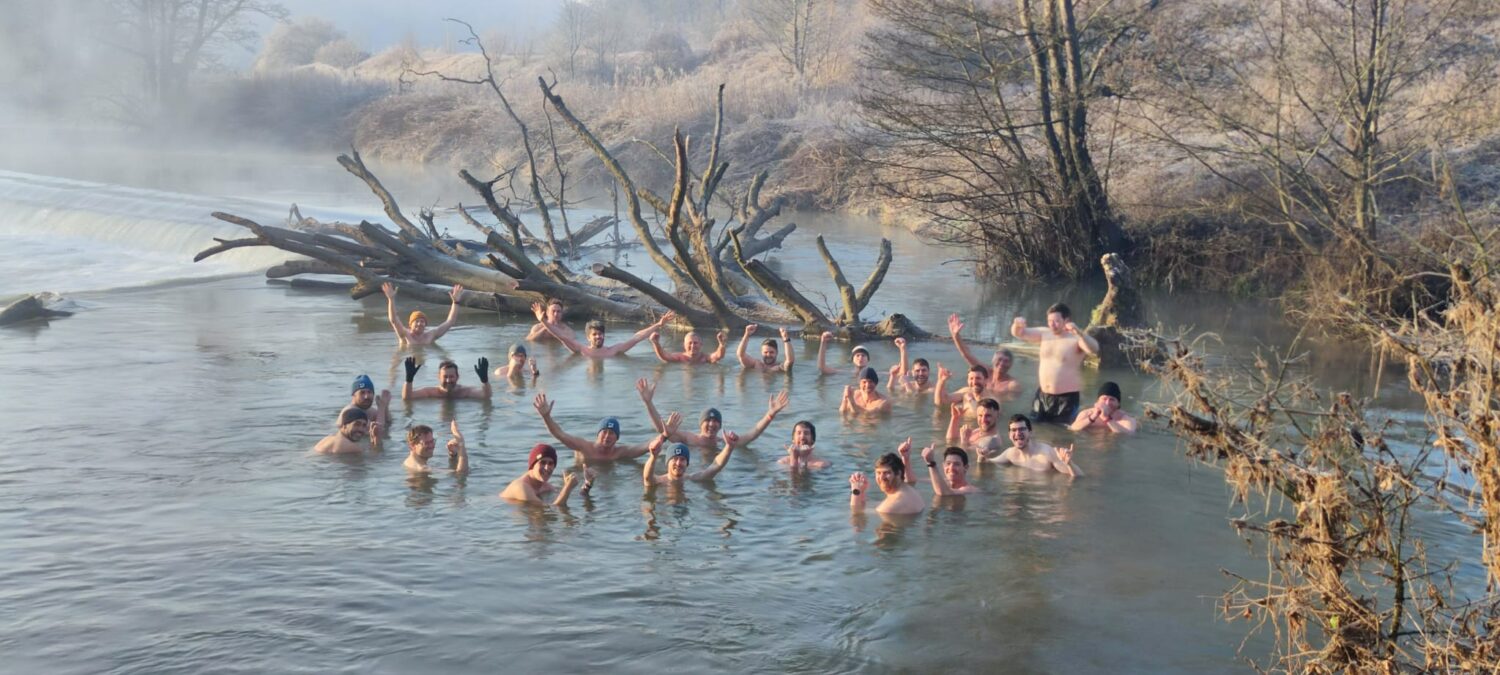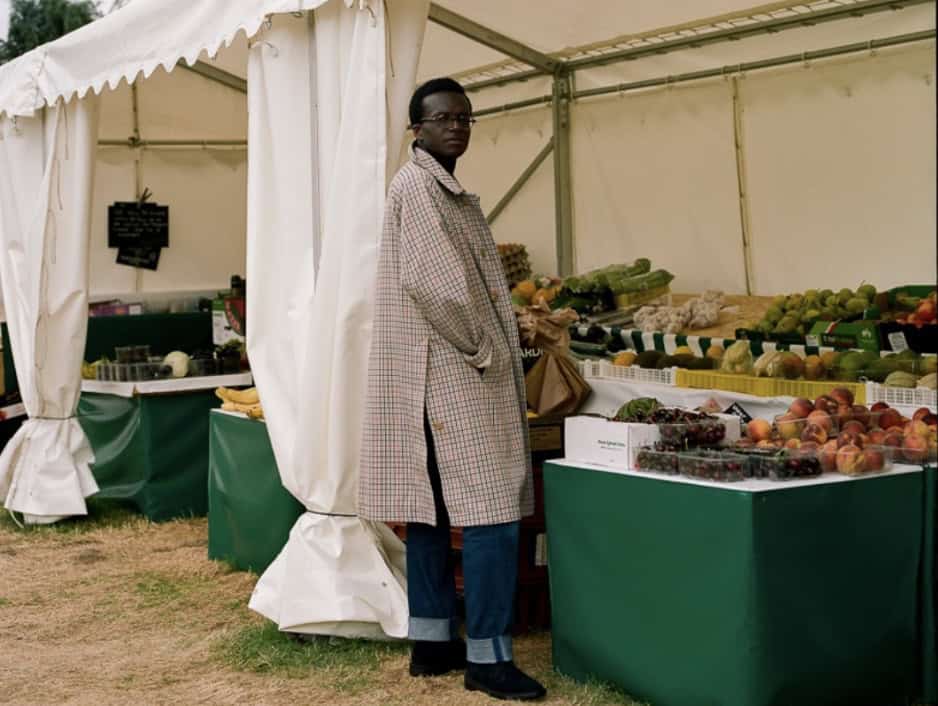Breaking the ice for men’s mental health
Dec 27, 2025The Secrets of Bruce Lee’s Legendary Workout
- Aug 16, 2024
- 0 Comments
695
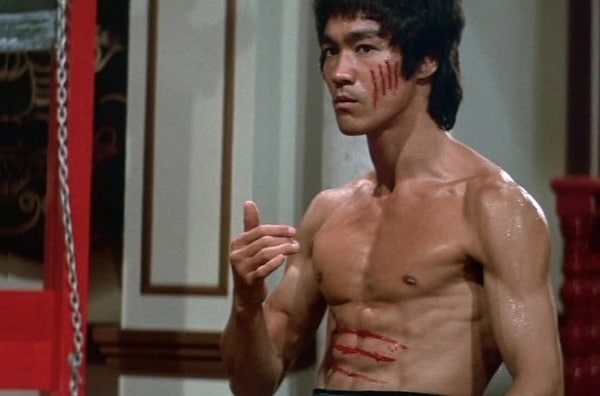
Bruce Lee is a legend.
He revolutionized movies and martial arts.
He also boasted incredible strength and all-around physicality.
Lee could place his fist one inch from the chest of a man twice his size and unleash a quick, cobra-like strike that’d send his opponent flying.
Lee could perform push-ups using just two fingers of one hand.
Lee wasn’t huge, but his lean, chiseled, defined physique was widely admired, and bodybuilders like Arnold Schwarzenegger, Lou Ferrigno, Flex Wheeler, Shawn Ray, and Dorian Yates all acknowledged the impact it had on their careers.
Co-star and fellow martial artist Chuck Norris described Lee’s ripped physique as “muscle upon muscle.”
A woman who asked if she could touch Bruce Lee’s flexed bicep (a common request he appreciated receiving) described it as “warm marble.”
How did Lee develop his strength and physique? Was he simply a genetic freak?
Nope. If you look at early pictures of the Little Dragon, he was a pretty scrawny guy.
Instead of genetics, Lee systematically and relentlessly built his body with physical training.
Thanks to the meticulous research of martial artist and writer John Little, we know exactly what Lee did to achieve his results. Little shares the details of Lee’s fitness training in his 1998 book Bruce Lee: The Art of Expressing the Human Body. The book is an absolute gold mine of fitness history and information, and I highly recommend picking up a copy.
In today’s article, we take a look at the principles that informed Bruce Lee’s training and the components of his regimen that turned a man into a legend.
The Moment Bruce Lee Got Serious About His Physical Training
Throughout his childhood, Lee was incredibly active. He got in trouble at school, and his spiritedness drove him to mischief and street fights. If Lee had grown up in the 21st century, he probably would have been diagnosed with ADHD. His hyperactivity inspired his family to call him “never sits still.”
To channel Lee’s energy into less destructive activities, his father signed him up for kung fu instruction under the tutelage of master Ip Man. Thus, at age thirteen, Bruce began the lifelong practice that would make him a worldwide legend.
By the time Lee was in his twenties, he had developed enough physical conditioning to excel as a martial artist, but remained a skinny guy.
Then came a moment that would take his physical training to the next level.
In the early 1960s, Lee lived in Oakland, CA, and had begun teaching kung fu. Lee didn’t discriminate in who he took on as a student, and according to some accounts, some traditional Chinese kung fu masters in the area weren’t happy with him teaching the martial art to non-Chinese. So in 1964, they presented an ultimatum to Lee: take part in a kung fu battle against their best fighter; if Lee lost, he had to shut down his kung fu class.
While different versions of exactly how the fight went down exist, according to Bruce, the fight lasted three minutes and primarily involved him chasing his opponent around a building until he forced him to submit.
Despite winning, Lee was disappointed with how he performed. He was unhappy about the shape he was in and had begun to feel that the parameters of traditional martial arts were impractical for street fights. He concluded that to realize his full physical potential and become the best martial artist in the world, he’d need to move beyond kung fu and expand his repertoire of physical modalities.
This moment of discontent not only inspired Bruce Lee to get serious about his physical fitness, but birthed a martial art and overall life philosophy he called Jeet Kune Do or the Way of the Intercepting Fist.
The Sources of Bruce Lee’s Physical Training Philosophy
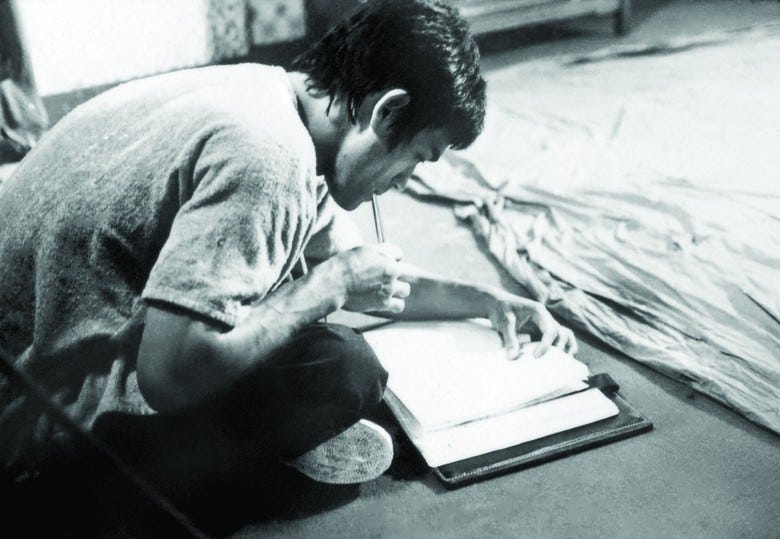
In moving forward from the fight, Lee sought to develop a physical training system that emphasized “practicality, flexibility, speed, and efficiency” and drew from a wide range of training methods.
While Jeet Kune Do sounds like a formal martial art style like Tae Kwon Do, Lee intended it to be “the style of no style” — a martial art that transcended formal rules and incorporated the best ideas from various disciplines.
To find these ideas, Lee became a devoted student of the art and science of physical training.
Even though Bruce had struggled in school, he had a strong commitment to continuous learning and was a voracious reader throughout his adulthood. Over his life, he amassed a huge personal library of over 2,500 titles.
He trained his mind by reading Eastern and Western philosophy (Summa Theologica by St. Thomas Aquinas; The Book of Five Rings by Miyamoto Musashi), as well as American self-help (As a Man Thinketh by James Allen; How to Win Friends and Influence People by Dale Carnegie).
He also religiously studied everything he could get his hands on about training the body.
Lee thought there was something to be learned from all combatives and read books about boxing by Jack Dempsey, Joe Louis, and Rocky Marciano, texts on karate and aikido, and over sixty volumes on fencing.
In the 1960s, bodybuilding magazines were the primary sources of information on strength training, and Bruce Lee subscribed to them all. If he found an article that contained useful information, he’d clip it and put it in his filing system.
Lee also browsed used bookstores and bought copies of health and fitness books from the late 19th and early 20th centuries, including Strength and How to Obtain It by bodybuilder and strongman Eugen Sandow and The Application of Measurement to Health and Physical Education written in 1945 by H. Harrison Clarke.
Lee continued to add fitness books to his extensive library throughout his life and never let a set lens contort his reading choices; if a book or magazine had some useful info in it, he bought it and read it.
Besides magazines and books, Lee would ask his friends and students for training advice. Two men who had a huge influence on Lee’s physical education were James Yimm Lee and Allen Joe. James Lee (no relation to Bruce Lee) was an Oakland-based martial artist and weightlifter, and Allen Joe was the first Chinese-American bodybuilding champion. Both men introduced Lee to the way of the iron and helped develop his first weightlifting program.
For a fuller list of the varied books in Bruce Lee’s personal library, check out this article.
The Elements of Bruce Lee’s Physical Training

If you’re talking about combat — as it is — well then, baby, you’d better train EVERY part of your body.
— Bruce Lee
Lee’s study of all aspects of physical training led him to experiment with different fitness modalities, including barbell training, isometrics, plyometrics, circuit training, running, and stretching.
His practice of these diverse modalities all had a single goal: becoming a better martial artist.
While Lee only chose exercises that would help him improve as a fighter, because martial arts require the full spectrum of physical capabilities (strength, power, speed, endurance, and flexibility), Lee systematically trained all these capabilities; he didn’t specialize.
Below, we’ll look at the main components of his physical training:
Weightlifting
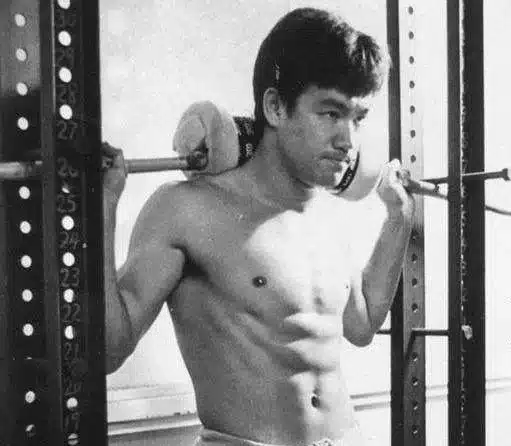
Thanks to his research and his own experience, Lee developed a deep appreciation for physical strength and believed it was the foundation of all other physical capacities. If you get stronger, you can move faster, with more power, for longer periods of time.
And the most effective and efficient way to get stronger is through resistance training.
In the early part of his training career, Lee used isometrics to build strength. Then he discovered the effectiveness of barbell training and began to pump iron.
While Lee’s weightlifting programming evolved throughout his life, if you look at his programming as a whole, five key elements emerge:
Compound Movements: One of the principles of Jeet Kune Do was economy of motion — using the shortest and most direct path to achieve the desired outcome and minimizing wasted movement and energy.
Thus when Lee chose an exercise for a workout, he looked for ones that could give him the most bang for his buck, like compound lifts, which work several muscle groups concurrently, promoting overall strength and power. Lee was a fan of squats, clean and presses, bench presses, and rows, feeling that these movements not only had high ROI for building strength, but also achieved the harmony between muscle groups that was essential for optimal power generation in martial arts.
Low Volume: While many sources claim that Lee used extremely high repetitions, John Little’s extensive review of Lee’s workout records showed that he typically employed a moderate rep range of 8-12 reps per set for most exercises. The exception was leg training, where he did favor higher repetitions and aimed for 12-20 reps per set.
Lee also kept the volume of his workouts low, doing only 1-2 sets per exercise. Lee was doing Mike Mentzer’s Heavy Duty program before Mike Mentzer.
Progressive Overload: Lee firmly believed in the overload principle and consistently strove to increase the demands on his body for continuous improvement. Depending on his fitness goals at the time, he’d try to achieve progressive overload by adding weight, increasing repetitions, or reducing his workout time.
Focus on Velocity: Lee prioritized speed and power because they often distinguished a great fighter from an average one. He understood that power is the ability to express strength quickly. To that end, he often incorporated velocity work into his weight training. Instead of using slow, controlled movements, Lee would make the concentric part of the lift quick and explosive.
Minimalist Approach: Another principle of Jeet Kune Do was simplicity, and this was reflected in Lee’s continual refinement of his weightlifting programs; he worked to eliminate unnecessary exercises to optimize results from minimal work. If you look at the evolution of Lee’s weightlifting workouts, they got shorter and shorter; he went from doing hour-and-a-half long workouts with a bunch of exercises to a workout with just a few movements that could be done in less than 30 minutes. By focusing on an effective selection of compound lifts, done at low volume, he got the results he wanted in short, intense workouts.
While Lee’s barbell-training workouts evolved over time, he eventually settled on a program in which he did a 20-minute session 3X a week (Tuesdays, Thursdays, and Saturdays) that often looked like this:
- Clean and press: 2 sets of 8 reps
- Squat: 2 sets of 12 reps
- Barbell pullover: 2 sets of 8 reps
- Bench press: 2 sets of 6 reps
- Good mornings: 2 sets of 8 reps
- Barbell curl: 2 sets of 8 reps
In addition to general weight training, one area of his body that Bruce Lee took time to do special exercises for was his forearms; we’ll be dedicating a whole post to his forearm-training routine down the road.
Cardio
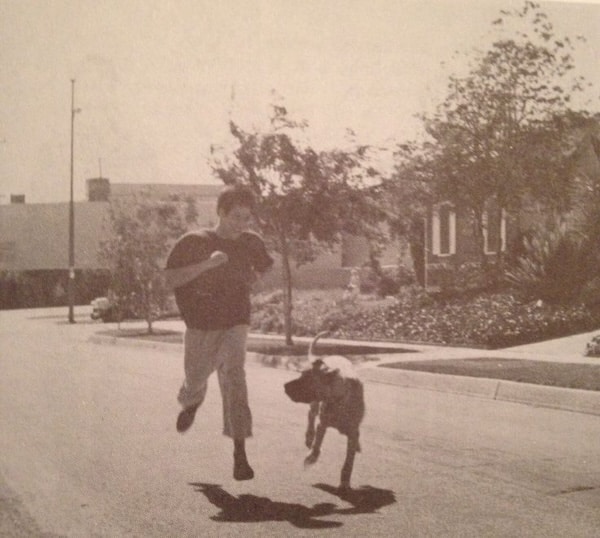
Lee caught the jogging bug in the 1970s. He thought running was an effective and safe way to improve his stamina and endurance. He’d jog two to six miles on Mondays, Wednesdays, and Fridays and would always have a pair of sneakers with him so he could get a run in even when he was away from home.
Lee incorporated the progressive overload principle into his running by increasing his speed or distance. He was also an early practitioner of the “heavy hands” method of aerobic activity and would hold light dumbbells or wear ankle weights while running.
Lee would sometimes supplement the running he did for cardiovascular health by cycling or jumping rope on Tuesdays, Thursdays, and Saturdays.
Stretching
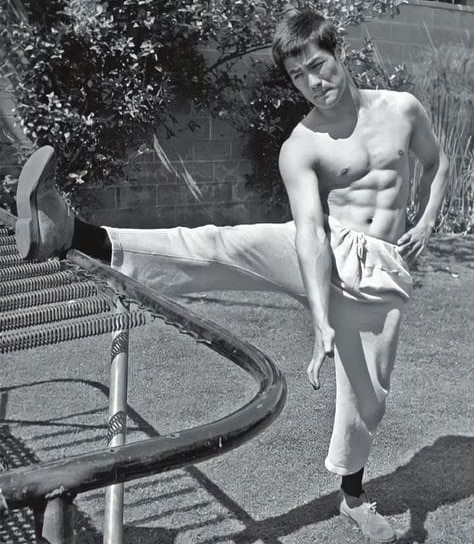
You’ve likely seen pictures of Lee displaying his phenomenal flexibility with one of his high kicks. That flexibility came from his commitment to daily stretching. Upon rising and before he got out of bed, he would do his “Wake-Up Routine” — a set of six stretches and body activation exercises:
- Full-body stretch: 5 times, maintaining stretch 3 seconds, rest 2 seconds
- Arch back: 5 times
- Leg tensing: 12 times, 3 seconds tensing, 2 seconds rest
- Abdominal tensing: 10 times, 3 seconds tensing, 2 seconds rest
- Sit-up, touch toes: 5 times
- Bent-leg raises: 5 times
Later in the morning, Lee would spend 15 to 20 minutes on a full stretching routine. He even created special equipment that would allow him to progressively overload his stretches.
Here’s an example of what one of his stretching sessions would look like:
- Seated straight leg stretch
- Side stretch
- Hurdle stretch
- Seated groin stretch/butterfly stretch
- Thigh stretch/standing quad stretch
- Front pulley stretch. This stretch required a pulley and rope set-up. While standing, Lee would place one foot in a strap connected to a rope and then pull on the rope, which would raise the leg into a stretched position.)
- Side pulley stretch. Same as front pulley stretch but the leg was placed in a side kick position.)
Besides his dedicated stretching sessions, Lee would stretch throughout the day. While he was reading, he often propped his leg up on a table or desk so he could get in some stretching while he developed his mind.
Core Work
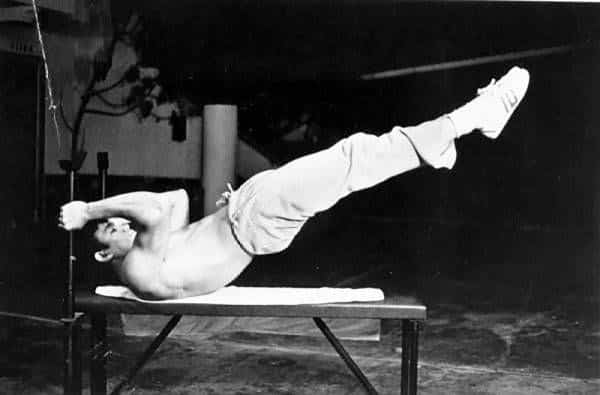
Lee believed that the abdomen was the “center or generator” of the body because it was the place in the body that coordinates all its parts and contributes to both punching and kicking power. Consequently, Lee trained his abs every day. The result was a powerful core and a tight, trim, 26-inch waist.
In addition to the famous dragon flag exercise, which Lee popularized, he did numerous other exercises for his stomach and waist. Here’s an example of one of the daily ab routines Lee did:
- Sit-ups: 4 sets of 20
- Side bend: 4 sets of 15 to 20. Lee would hold dumbbells in his hands to increase the intensity of this movement.
- Leg raises: 4 sets of 20
- Twists: 4 sets of 50. To perform this movement, Lee would hold a stick across his shoulders, bend forward at the hips and twist right, aiming the left stick end toward his right foot. After returning to the upright position, he would then twist left to bring the right stick end toward his left foot.
- Frog kicks: 4 sets of 20. Lee performed this exercise by hanging from a pull-up bar and raising his knees up to touch his chest.
Punching and Kicking
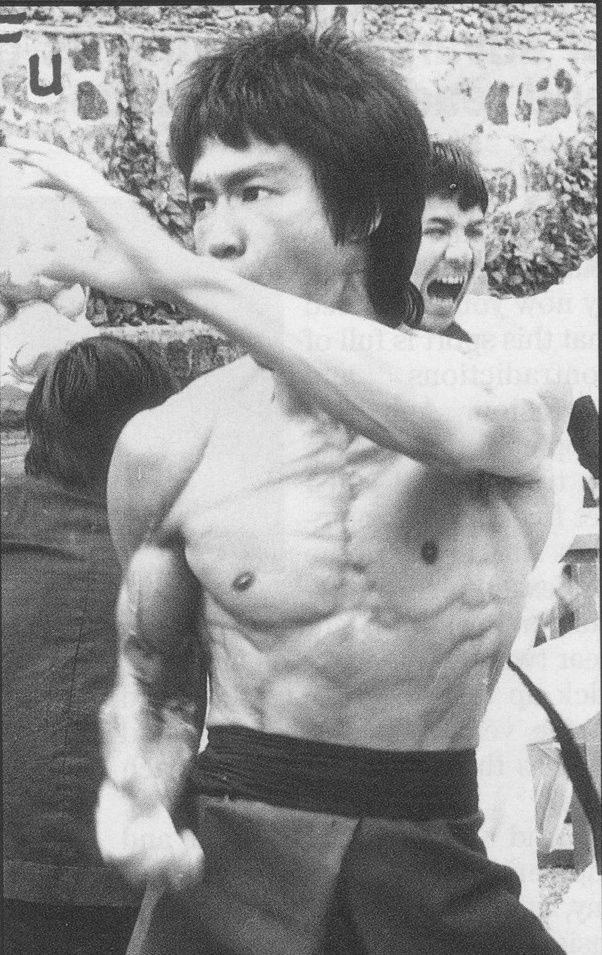
Of course, martial arts training was part of Lee’s physical regimen. He’d alternate days where he’d work on combative leg moves with days he’d focus on arms and hands. He often aimed to do 500 punches a day and threw some of these punches while holding light weights. He’d focus on speed and endurance with his kicking and punching sessions, but would also train power by incorporating work with a heavy bag.
Below is a kicking and punching routine that Lee used in 1970:
Kicking
- Side kick: left and right
- Hook kick: left and right
- Spin kick: left and right
- Rear front thrust: left and right
- Heel kick: left and right
Punching
- Jab: speed bag, foam pad, top and bottom bag
- Cross: speed bag, foam pad, top and bottom bag
- Hook: speed bag, foam pad, top and bottom bag
- Overhand cross: speed bag, foam pad, heavy bag
- Combinations: heavy bag, top and bottom speed bag
An Example of Bruce Lee’s Training Routine
Lee trained throughout the day, nearly every day. He did several hours of daily exercise, scheduled into morning, afternoon, and evening sessions that were each focused on training a particular modality.
What he did during those sessions evolved over time, according to what he had learned in his studies, the particular movie he was next to star in, and his personal goals.
But to give you an idea of how he brought together the above elements and incorporated them into his daily routine, here is an example of one of his training schedules from 1970:
Monday
- 7 AM to 8 AM: Ab work and Flexibility
- 12 PM to 1 PM: Run
- 5:30 PM to 6:30 PM: Punching
Tuesday
- 7 AM to 8 AM: Ab work and Flexibility
- 12 PM to 1 PM: Resistance Training
- 5:30 PM to 6:30 PM: Kicking
Wednesday
- 7 AM to 8 AM: Ab work and Flexibility
- 12 PM to 1 PM: Run
- 5:30 PM to 6:30 PM: Punching
Thursday
- 7 AM to 8 AM: Ab work and Flexibility
- 12 PM to 1 PM: Resistance Training
- 5:30 PM to 6:30 PM: Kicking
Friday
- 7 AM to 8 AM: Ab work and Flexibility
- 12 PM to 1 PM: Run
- 5:30 PM to 6:30 PM: Punching
Saturday
- 7 AM to 8 AM: Ab work and Flexibility
- 12 PM to 1 PM: Resistance Training
- 5:30 PM to 6:30 PM: Kicking
Sunday
The Overarching Secret of the Jeet Kune Do Way to Physical Fitness: Self-Expression

Absorb what is useful; reject what is useless, and add what is specifically your own.
—Bruce Lee
Perhaps the most important component of Bruce Lee’s approach to physical training is that he made it uniquely his own.
Each practitioner of Jeet Kune Do is encouraged to develop his own “personal style” within its framework. For Lee, both fighting specifically, and physical training generally, was not some rote habit you went through the motions with and rotely checked off your to-do list each day. Instead, movement was something you put “emotional content” and “passionate meaning” into. For Lee, physicality was existential.
To reach the heights of his potential, Lee created ever-changing training protocols that were suited to him and his personal goals. He didn’t follow cookie cutter programs. He didn’t follow exactly what the experts told him he was supposed to do.
He experimented. He acted. He felt into his training until he had discovered his personal training style — his way to “fully express the human body.”
Source:
Bruce Lee: The Art of Expressing the Human Body by John Little
Publisher: Source link


